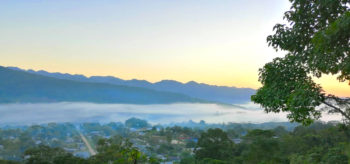
CNI
(Español) Resumen anual 2018 – 1 – Lucha de las comunidades zapatistas
2018 estuvo marcado por dos intentos por parte del EZLN y las comunidades indígenas en resistencia. Estas iniciativas pueden ser vistas como la práctica de la resistencia y de la rebeldía.
Creación del CIG y candidatura independiente
El eje de la resistencia consistió en la formación del Concejo Indígena de Gobierno (CIG) que busca amplificar el ejemplo del gobierno propio de las comunidades indígenas en varias geografías de México. El Concejo tuvo como principal expresión la campaña de denuncia encabezada por su vocera María de Jesús Patricio, Marichuy. De acuerdo con las palabras dadas de conocer en los primeros meses del año, la participación del CIG, Marichuy y sus aliad@s en el proceso electoral de 2018, tuvo como principal objetivo volver al colocar en el debate nacional la guerra de exterminio contra los pueblos originarios.
La experiencia se saldó con la recolección de 281,955 firmas de apoyo para pedir el registro de la compañera como candidata presidencial independiente. En marzo de 2018, al presentar los resultados de la campaña, el CIG, el EZLN, el Congreso Nacional Indígena (CNI) y la Asociación “Llegó la hora del florecimiento de los pueblos”, afirmaron: “Nuestro caminar sigue. Y la diferencia fundamental con las etapas anteriores es que ahora somos más pueblos originarios caminando juntos, y, LO MÁS IMPORTANTE, ahora somos más personas, grupos, colectivos y organizaciones orientadas a buscar en nosotr@s mism@s las soluciones que, lo sabemos, no vendrán nunca de arriba”.
El balance de esta iniciativa es contrastado dado que si bien se logró colocar la situación de los pueblos originarios en el debate público, la campaña no logró alcanzar un apoyo que parecía factible, a la luz de otras iniciativas impulsadas por el EZLN y sus aliados. Acaso la limitada respuesta a la campaña de firmas tuvo que ver con el ingreso del movimiento indígena en el espacio de la política institucional, incursión que tuvo muchas lecturas desfavorables, desde quienes vieron en ella un intento por restarle votos a López Obrador hasta quienes rechazaron la participación del zapatismo en las elecciones.
(Español) Servilleta para un monero indolente, o por qué oponerse a un tren devastador

Amanecer en La Realidad, Chiapas, México. Selva Maya. Foto: Radio Zapatista.
Eugenia Gutiérrez, Colectivo RZ.
México, enero de 2019.
No es sólo porque esta democracia fallida no divisa rumbo. No es nada más porque su instrumentación y su funcionamiento estarían en manos de un equipo político ineficiente, sin ideas propias, sin voz, dedicado a cumplir los caprichos de un patriarca. Si nuestra oposición se fundamentara en eso estaríamos coincidiendo en argumentos con una franja social muy amplia que anhela liderazgos y patrones, siempre que éstos le garanticen tener la habilidad para atajar timones con firmeza, sin importar su sello neoliberal y capitalista o precisamente por eso. Para nuestra oposición a proyectos como el ferrocarril peninsular, el corredor transístmico y otras ambiciones de corte neoliberal existen otras razones. He aquí algunas.






